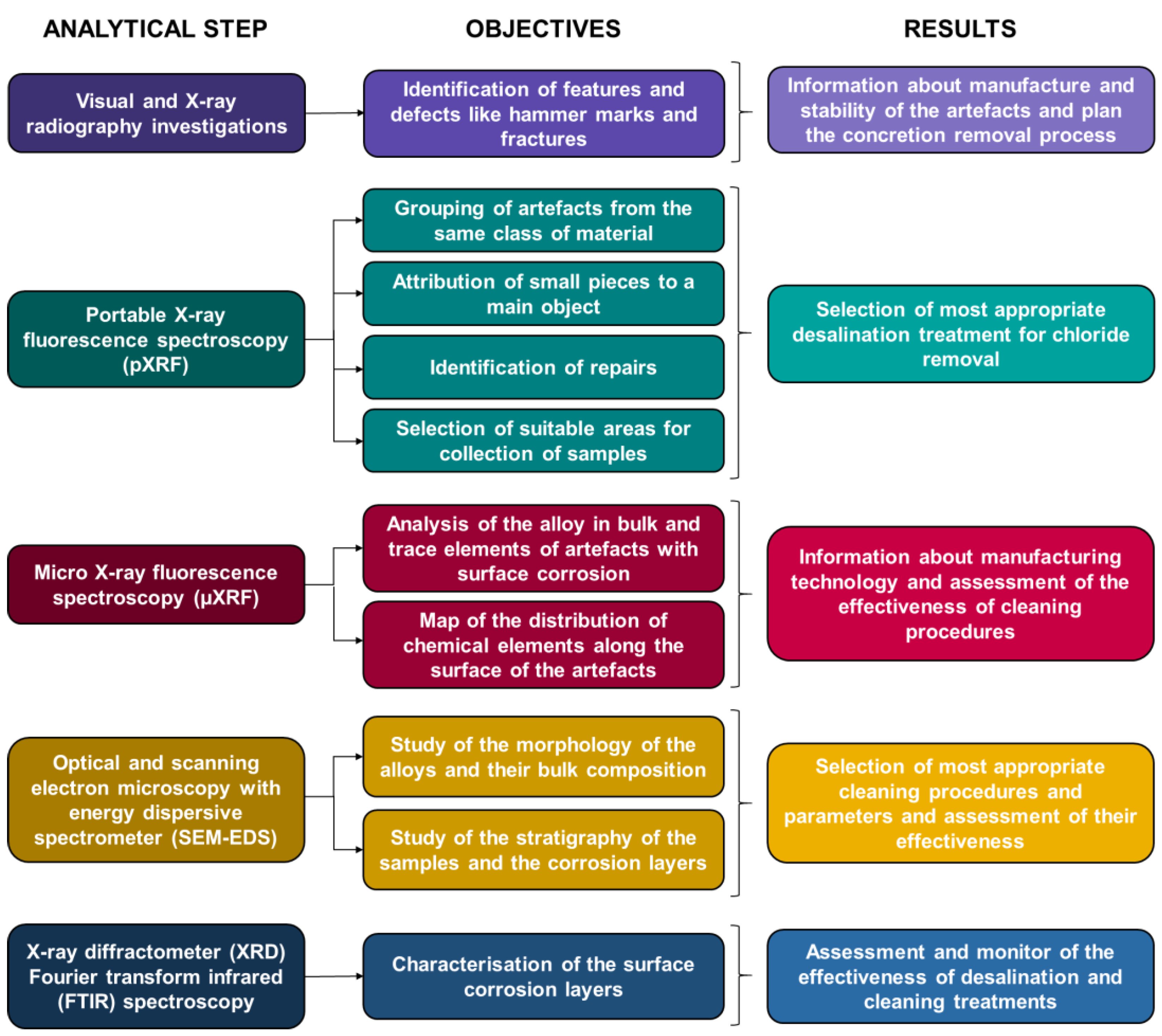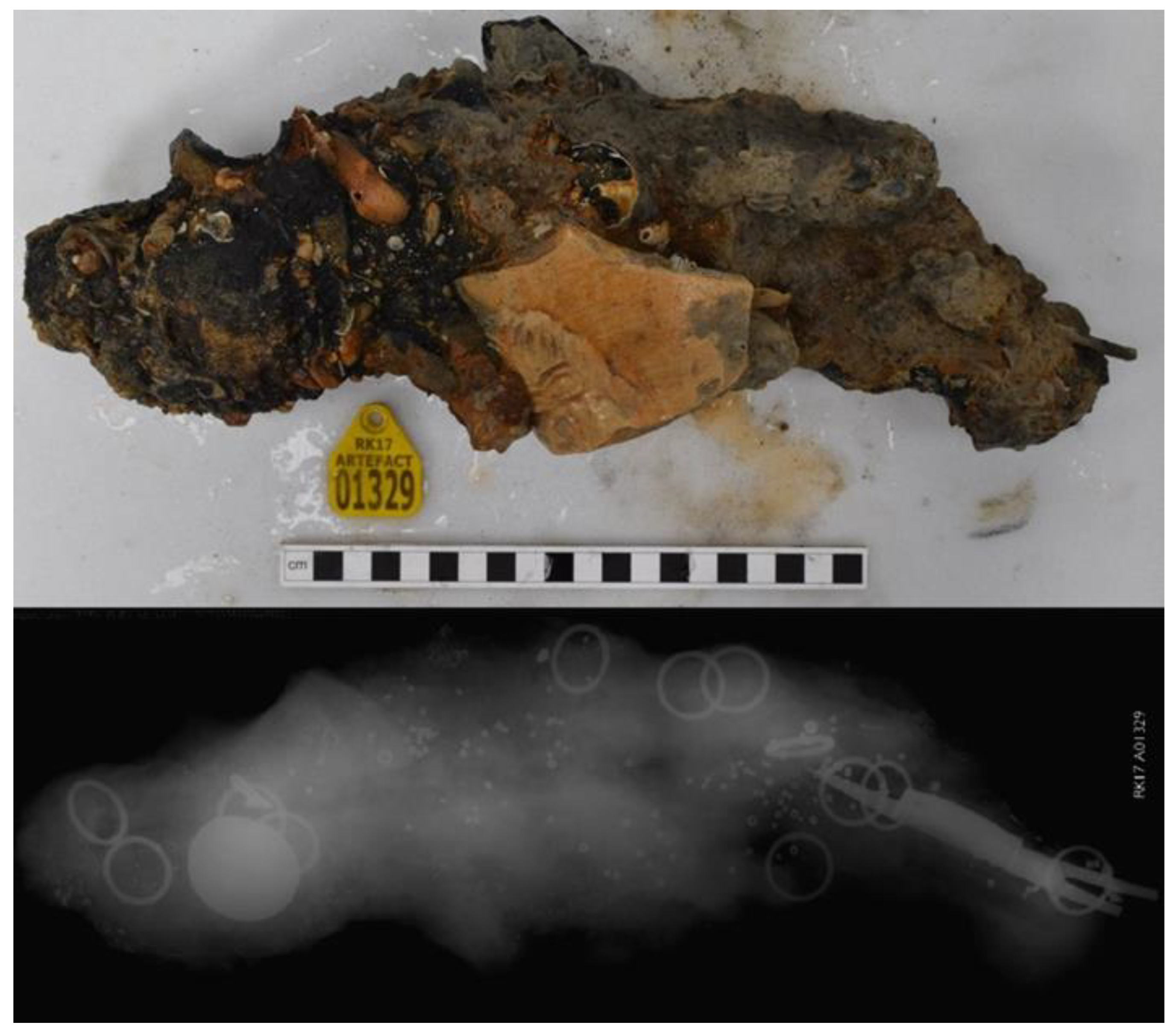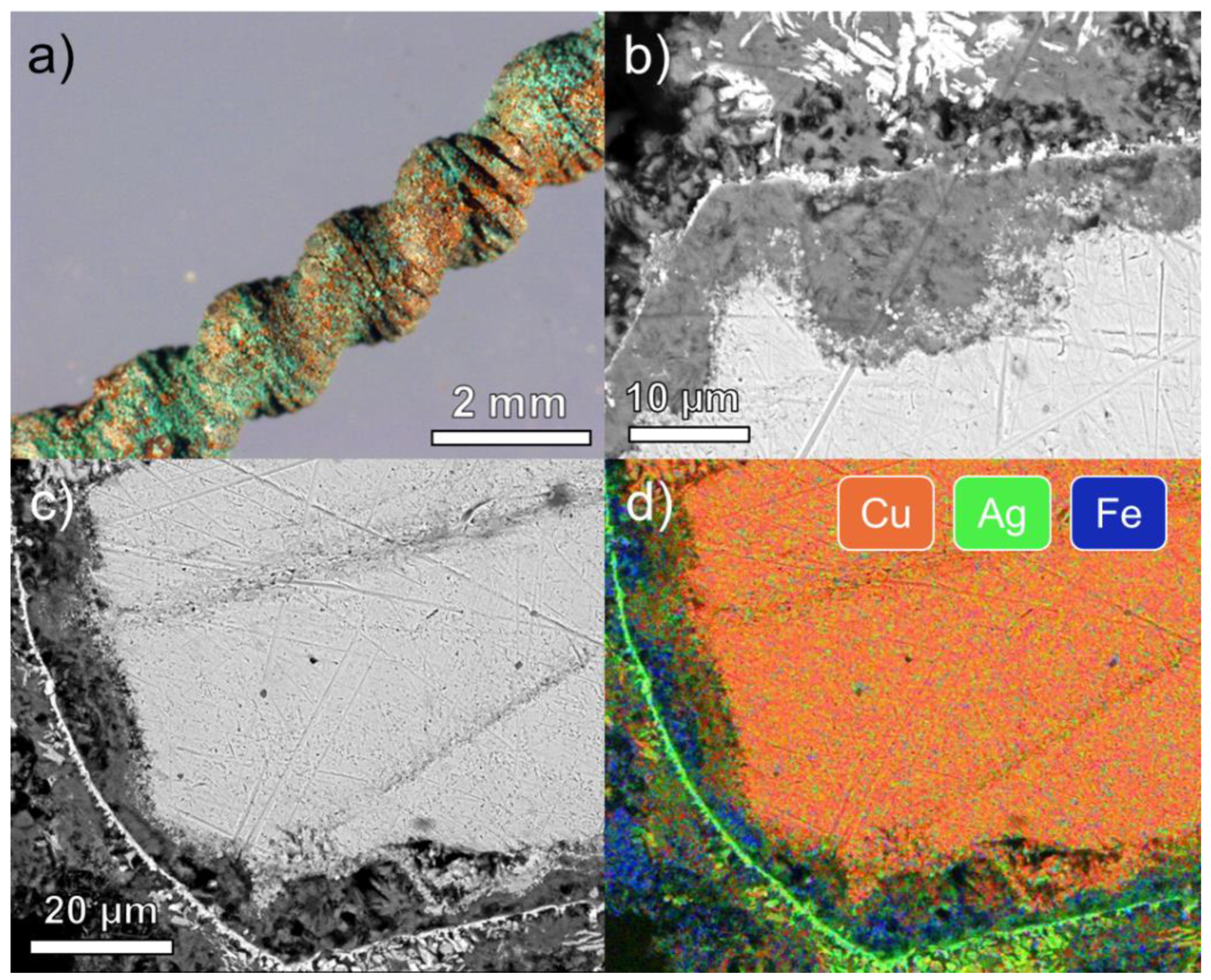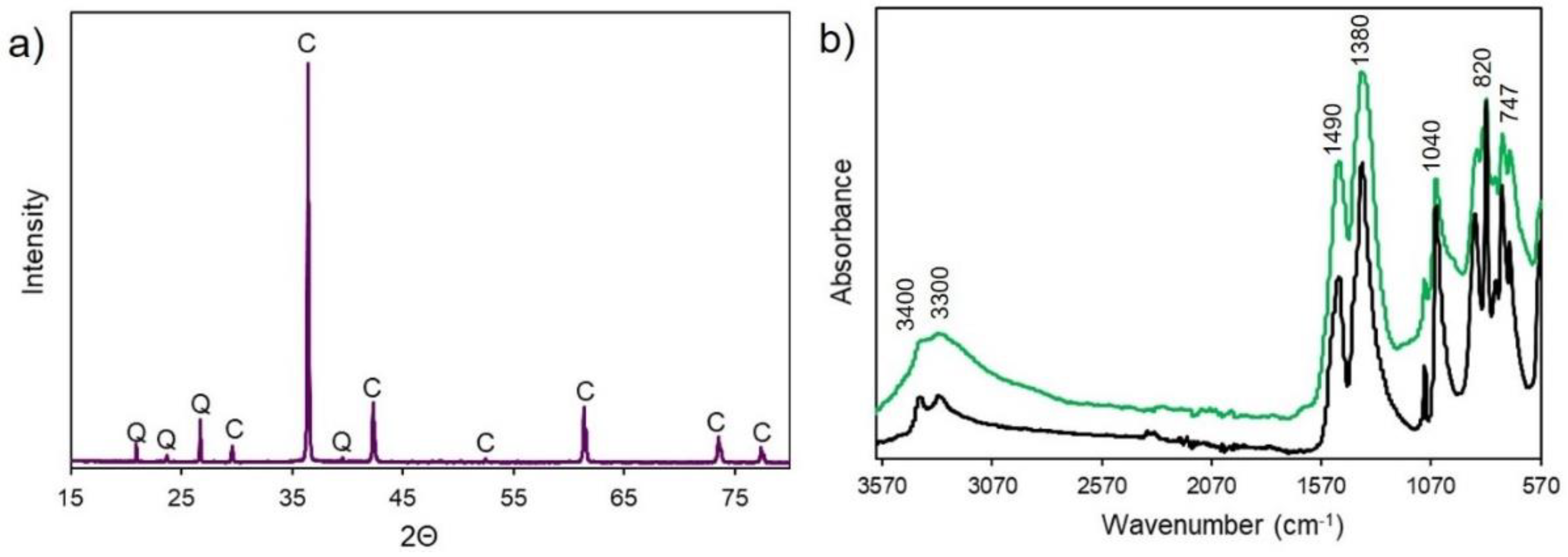A Multi-Analytical Protocol for Decision Making to Study Copper Alloy Artefacts from Underwater Excavations and Plan Their Conservation
Abstract
1. Introduction
2. Materials and Methods
2.1. The Protocol
2.2. Experimental Conditions
3. Results
3.1. The State of Preservation and Conservation of the Copper Alloy Artefacts
3.2. Application of the Protocol in Case-Studies
3.2.1. Visual and X-ray Radiography Investigations
3.2.2. Evaluation of the Elemental Composition by pXRF, µXRF and SEM-EDS
3.2.3. Characterisation of Corrosion Layers and Surface Patina by FTIR Spectroscopy and XRD
4. Conclusions
Supplementary Materials
Author Contributions
Funding
Institutional Review Board Statement
Informed Consent Statement
Data Availability Statement
Acknowledgments
Conflicts of Interest
References
- Rooswijk1740: Project Overview. Available online: https://english.cultureelerfgoed.nl/topics/maritime-heritage/rooswijk1740 (accessed on 10 October 2022).
- Rooswijk1740: The Post Excavation Phase. Available online: https://historicengland.org.uk/whats-new/research/rooswijk-shipwreck-excavation-the-post-excavation-phase/ (accessed on 10 October 2022).
- Rooswijk1740: Virtual Dive Trail. Available online: https://www.cloudtour.tv/Rooswijk (accessed on 10 October 2022).
- Robbiola, L.; Portier, R. A global approach to the authentication of ancient bronzes based on the characterization of the alloy–patina–environment system. J. Cult. Herit. 2006, 7, 1–12. [Google Scholar] [CrossRef]
- Aucouturier, M.; Darque-Ceretti, E. The surface of cultural heritage artefacts: Physicochemical investigations for their knowledge and their conservation. Chem. Soc. Rev. 2007, 36, 1605–1621. [Google Scholar] [CrossRef] [PubMed]
- Neff, D.; Reguer, S.; Dillmann, P. 4—Analytical techniques for the study of corrosion of metallic heritage artefacts: From micrometer to nanometer scales. In Corrosion and Conservation of Cultural Heritage Metallic Artefacts; Dillmann, P., Watkinson, D., Angelini, E., Adriaens, A., Eds.; Woodhead Publishing: Sawston, UK, 2013; pp. 55–81. [Google Scholar]
- Ingo, G.M.; Riccucci, C.; Faraldi, F.; Casaletto, M.P.; Guida, G. Micro-chemical and micro-structural investigation of the corrosion products on “The Dancing Satyr” (Mazara del Vallo, Sicily, Italy). Appl. Phys. A 2010, 100, 785–792. [Google Scholar] [CrossRef]
- Angelini, E.; Grassini, S.; Tusa, S. 12—Underwater corrosion of metallic heritage artefacts. In Corrosion and Conservation of Cultural Heritage Metallic Artefacts; Dillmann, P., Watkinson, D., Angelini, E., Adriaens, A., Eds.; Woodhead Publishing: Sawston, UK, 2013; pp. 236–259. [Google Scholar]
- Ashkenazi, D.; Cvikel, D.; Stern, A.; Klein, S.; Kahanov, Y. Metallurgical characterization of brass objects from the Akko 1 shipwreck, Israel. Mater. Charact. 2014, 92, 49–63. [Google Scholar] [CrossRef]
- Ciarlo, N.C.; Maxia, G.; Rañi, M.; De Rosa, H.; Geli Mauri, R.; Vivar Lombarte, G. Craft production of large quantities of metal artifacts at the beginnings of industrialization: Application of SEM–EDS and multivariate analysis on sheathing tacks from a British transport sunk in 1813. J. Archaeol. Sci. Rep. 2016, 5, 263–275. [Google Scholar] [CrossRef]
- Żmuda-Trzebiatowska, I.; Schaefer, K.; Sokołowska, A.; Rodzik, I.; Sobczyk, A.T.; Karczewski, J.; Śliwiński, G. Raman investigation of the patina layers on Hungarian copper ingots from a fifteenth century shipwreck. J. Raman Spectrosc. 2016, 47, 1528–1533. [Google Scholar] [CrossRef]
- Inberg, A.; Ashkenazi, D.; Cohen, M.; Iddan, N.; Cvikel, D. Corrosion products and microstructure of copper alloy coins from the Byzantine-period Ma’agan Mikhael B shipwreck, Israel. Microchem. J. 2018, 143, 400–409. [Google Scholar] [CrossRef]
- Ingo, G.M.; Riccucci, C.; Guida, G.; Pascucci, M.; Giuliani, C.; Messina, E.; Fierro, G.; Di Carlo, G. Micro-chemical investigation of corrosion products naturally grown on archaeological Cu-based artefacts retrieved from the Mediterranean sea. Appl. Surf. Sci. 2019, 470, 695–706. [Google Scholar] [CrossRef]
- van der Stok-Nienhuis, J.; Kuiper, E.; Beentjes, T.; Joosten, I.; van Eijck, L.; Zhou, Z.; van Bommel, M. A case study for scientific research prior to conservation of marine metal artefacts. J. Archaeol. Sci. Rep. 2021, 37, 102909. [Google Scholar] [CrossRef]
- Armetta, F.; Saladino, M.L.; Scherillo, A.; Caponetti, E. Microstructure and phase composition of bronze Montefortino helmets discovered Mediterranean seabed to explain an unusual corrosion. Sci. Rep. 2021, 11, 23022. [Google Scholar] [CrossRef] [PubMed]
- Analytical Methods Committee, A.N. Hand-held X-ray fluorescence analysis of archaeological artefacts: Challenges, advantages and limitations. Anal. Methods 2021, 13, 3731–3734. [Google Scholar] [CrossRef]
- Colomban, P.; Gironda, M.; Simsek Franci, G.; d’Abrigeon, P. Distinguishing Genuine Imperial Qing Dynasty Porcelain from Ancient Replicas by On-Site Non-Invasive XRF and Raman Spectroscopy. Materials 2022, 15, 5747. [Google Scholar] [CrossRef] [PubMed]
- Derrick, M.; Stulik, D.; Landry, J. Infrared Spectroscopy in Conservation Science; Getty Publications: Los Angeles, CA, USA, 1999. [Google Scholar]
- Kendix, E.; Moscardi, G.; Mazzeo, R.; Baraldi, P.; Prati, S.; Joseph, E.; Capelli, S. Far infrared and Raman spectroscopy analysis of inorganic pigments. J. Raman Spectrosc. 2008, 39, 1104–1112. [Google Scholar] [CrossRef]
- Dunkley, M. Rooswijk Goodwin Sands, off Kent: Conservation statement & management plan. In English Heritage Report; English Heritage: Swindon, UK, 2009. [Google Scholar]
- Pascoe, D. Multi-Beam Surveys of the Designated Wrecks on the Goodwin Sands and the Downs, 2018 report. Hist. Engl. Res. Rep. 2020, 243, 2020. [Google Scholar]
- Scott, D.A.; Institute, G.C. Copper and Bronze in Art: Corrosion, Colorants, Conservation; Getty Conservation Institute: Los Angeles, CA, USA, 2002. [Google Scholar]
- Pearson, C. Conservation of Marine Archaeological Objects; Elsevier Science: Amsterdam, The Netherlands, 1988. [Google Scholar]
- Vereecke, H.; Frühmann, B.; Schreiner, M. The Chemical Composition of Brass in Nuremberg Trombones of the Sixteenth Century. Hist. Brass Soc. J. 2012, 24, 61–77. [Google Scholar] [CrossRef]
- Elsener, B.; Alter, M.; Lombardo, T.; Ledergerber, M.; Wörle, M.; Cocco, F.; Fantauzzi, M.; Palomba, S.; Rossi, A. A non-destructive in-situ approach to monitor corrosion inside historical brass wind instruments. Microchem. J. 2016, 124, 757–764. [Google Scholar] [CrossRef]
- Craddock, P.T.; Eckstein, K. Production of brass in antiquity by direct reduction. In Mining and Metal Production through the Ages; Craddock, P.T., Lang, J., Eds.; British Museum Press: London, UK, 2003. [Google Scholar]
- Bourgarit, D.; Bauchau, F. The ancient brass cementation processes revisited by extensive experimental simulation. JOM 2010, 62, 27–33. [Google Scholar] [CrossRef]
- Scott, D.A.; Schwab, R. The Metallurgy of Pre-industrial Metals and Alloys. In Metallography in Archaeology and Art; Springer International Publishing: Cham, Switzerland, 2019; pp. 133–206. [Google Scholar]
- Dungworth, D. Roman Copper Alloys: Analysis of Artefacts from Northern Britain. J. Archaeol. Sci. 1997, 24, 901–910. [Google Scholar] [CrossRef]
- Santos, C.I.S.; Mendonça, M.H.; Fonseca, I.T.E. Corrosion of brass in natural and artificial seawater. J. Appl. Electrochem. 2006, 36, 1353–1359. [Google Scholar] [CrossRef]
- Zhang, X.; Odnevall Wallinder, I.; Leygraf, C. Mechanistic studies of corrosion product flaking on copper and copper-based alloys in marine environments. Corros. Sci. 2014, 85, 15–25. [Google Scholar] [CrossRef]
- Savelli, S.; van Bork, E.; Meijer, S.; Joosten, I. Metal Threads in 17th Century Textiles: Technological Research of the Findings of Burgzand North 17 Shipwreck. In Proceedings of the Metal 2019 Proceedings of the Interim Meeting of the ICOM-CC Metals Working Group, Neuchâtel, Switzerland, 2–6 September 2019; pp. 41–44. [Google Scholar]
- Muros, V.; Wärmländer, S.K.T.S.; Scott, D.A.; Theile, J.M. Characterization of 17Th-19Th Century Metal Threads from the Colonial Andes. J. Am. Inst. Conserv. 2007, 46, 229–244. [Google Scholar] [CrossRef]
- Frost, R.L.; Martens, W.N.; Rintoul, L.; Mahmutagic, E.; Kloprogge, J.T. Raman spectroscopic study of azurite and malachite at 298 and 77 K. J. Raman Spectrosc. 2002, 33, 252–259. [Google Scholar] [CrossRef]
- Zaffino, C.; Guglielmi, V.; Faraone, S.; Vinaccia, A.; Bruni, S. Exploiting external reflection FTIR spectroscopy for the in-situ identification of pigments and binders in illuminated manuscripts. Brochantite and posnjakite as a case study. Spectrochim. Acta Part A Mol. Biomol. Spectrosc. 2015, 136, 1076–1085. [Google Scholar] [CrossRef] [PubMed]








| Object | Cu | Zn | Pb | Fe | Ni | As | Ag | Sn | Sb | Material | N. |
|---|---|---|---|---|---|---|---|---|---|---|---|
| Beads | 85 ± 11 | 0.36 ± 0.28 | 13 ± 10 | 0.58 ± 0.51 | 0.18 ± 0.07 | 0.20 ± 0.12 | 0.045 ± 0.035 | 0.54 ± 0.18 | 0.55 ± 0.14 | Leaded copper | 30 |
| Rings | 72 ± 3 | 22 ± 3 | 4.0 ± 1.2 | 0.67 ± 0.28 | 0.12 ± 0.03 | 0.27 ± 0.15 | 0.049 ± 0.044 | 0.35 ± 0.42 | 0.23 ± 0.21 | Leaded brass | 41 |
| Wires | 94 ± 8 | 0.065 ± 0.053 | 0.017 ± 0.007 | 5.7 ± 7.7 | 0.058 ± 0.013 | 0.080 ± 0.11 | 0.34 ± 0.54 | 0.067 ± 0.064 | 0.065 ± 0.072 | Copper | 3 |
| Candle holders | 71 ± 4 | 16 ± 4 | 7.6 ± 3.6 | 0.77 ± 0.41 | 0.37 ± 0.07 | 0.49 ± 0.12 | 0.062 ± 0.027 | 3.0 ± 0.8 | 0.77 ± 0.54 | Leaded brass | 10 |
| Candle snufffers | 73 ± 5 | 24 ± 5 | 2.2 ± 0.6 | 0.56 ± 0.21 | 0.16 ± 0.10 | 0.22 ± 0.08 | 0.12 ± 0.20 | 0.043 ± 0.055 | 0.015 ± 0.016 | Leaded brass | 7 |
| Thimbles | 73 ± 6 | 23 ± 5 | 2.9 ± 0.4 | 1.3 ± 2.0 | 0.057 ± 0.015 | 0.12 ± 0.04 | 0.046 ± 0.025 | 0.11 ± 0.15 | bd | Leaded brass | 26 |
Publisher’s Note: MDPI stays neutral with regard to jurisdictional claims in published maps and institutional affiliations. |
© 2022 by the authors. Licensee MDPI, Basel, Switzerland. This article is an open access article distributed under the terms and conditions of the Creative Commons Attribution (CC BY) license (https://creativecommons.org/licenses/by/4.0/).
Share and Cite
Gherardi, F.; Stewart, H. A Multi-Analytical Protocol for Decision Making to Study Copper Alloy Artefacts from Underwater Excavations and Plan Their Conservation. Coatings 2022, 12, 1640. https://doi.org/10.3390/coatings12111640
Gherardi F, Stewart H. A Multi-Analytical Protocol for Decision Making to Study Copper Alloy Artefacts from Underwater Excavations and Plan Their Conservation. Coatings. 2022; 12(11):1640. https://doi.org/10.3390/coatings12111640
Chicago/Turabian StyleGherardi, Francesca, and Heather Stewart. 2022. "A Multi-Analytical Protocol for Decision Making to Study Copper Alloy Artefacts from Underwater Excavations and Plan Their Conservation" Coatings 12, no. 11: 1640. https://doi.org/10.3390/coatings12111640
APA StyleGherardi, F., & Stewart, H. (2022). A Multi-Analytical Protocol for Decision Making to Study Copper Alloy Artefacts from Underwater Excavations and Plan Their Conservation. Coatings, 12(11), 1640. https://doi.org/10.3390/coatings12111640






